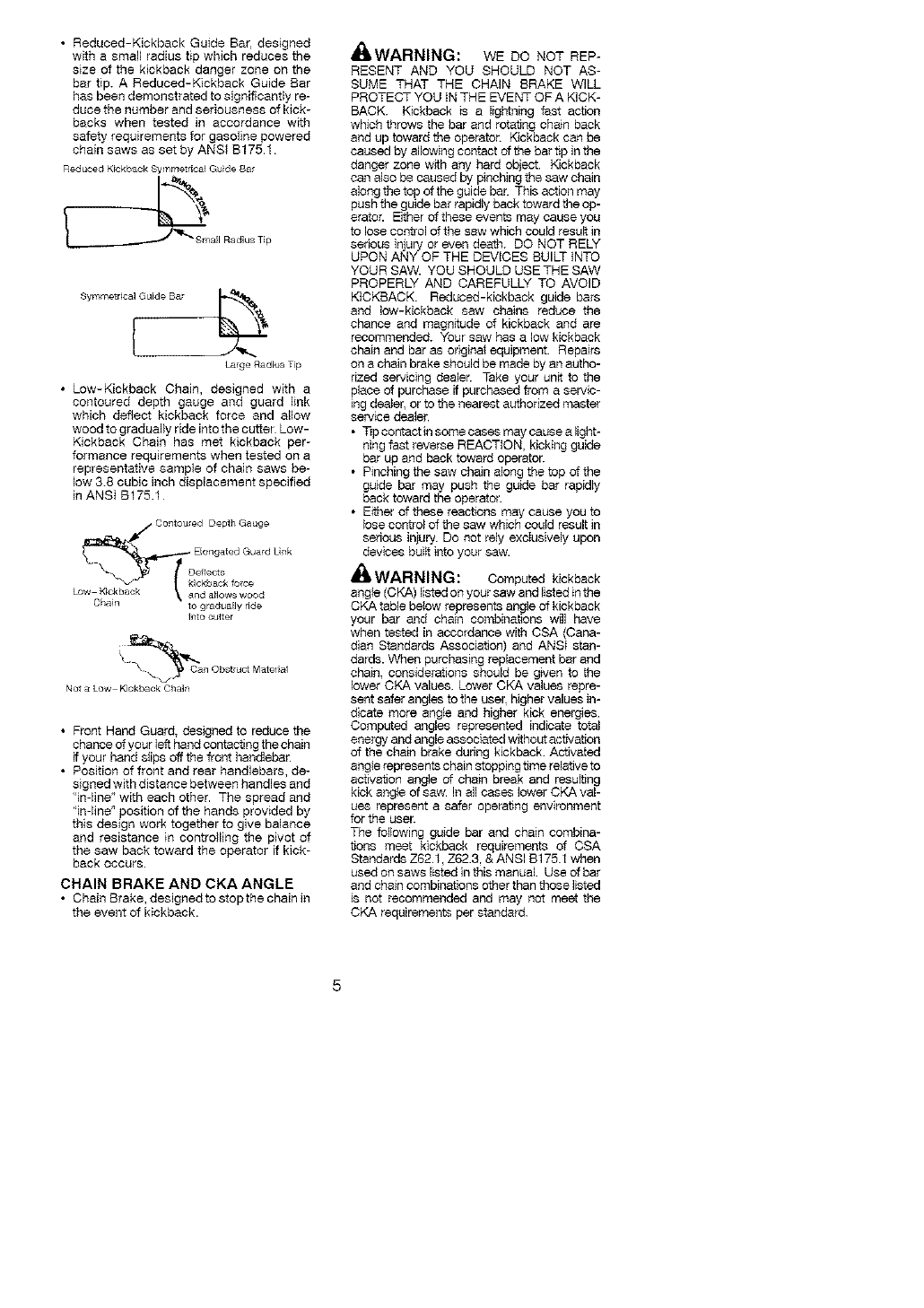
• Reduced-KickbackGuideBar,designed
withasmallradiustipwhichreducesthe
sizeofthekickbackdangerzone on the
bar tip. A Reduced-Kickback Guide Bar
has been demonstrated to significantly re-
duce the number and seriousness of kick-
becks when tested in accordance with
safety requirements for gasoline powered
chain saws as set by ANSI B175.1
ReducedKickbackSymrnetricalGuideBar
allRadiusTip
Symrnetrica_ Guide Bar _.,._
Large Radius Tip
• Low-Kickback Chain, designed with a
contoured depth gauge and guard link
which dedect kickback force and allow
wood to gradually ride into the cutter Low-
Kickback Chain has met kickback per-
formance requirements when tested on a
representative sample of chain saws be-
low 3.8 cubic inch displacement specified
in ANSi B175.1
Chain to gradualJy ride
_ntocutter
_ _X _C an ObstructMatelial
%
N_ a LOW Kickback Chain
• Front Hand Guard, designed to reduce the
chance of your Ieft hand contacting the chain
ifyour hand slips off the front handlebar.
• Position of front and rear handlebars, de-
signed with distance between handles and
'ingJne" with each other. The spread and
"in-line" position of the hands provided by
this design work together to give balance
end resistance in controlling the pivot of
the saw back toward the operator if kick-
back occurs.
CHAIN BRAKE AND CKA ANGLE
• Chain Brake, designed to stop the chain in
the event of kickback.
,tt _____._A
dnI_W/-_I-(NIN£_: WE DO NOT REP-
RESENT AND YOU SHOULD NOT AS-
SUME THAT THE CHAIN BRAKE WILL
PROTECT YOU IN THE EVENT OFA KICK-
BACK. Kickback is a lightning fast action
which throws the bar and rotating chain back
and up toward the operator. Kickback can be
caused by allowing contact of the bar tip in tile
danger zone wifh any hard object Kickback
can also be caused by pinching the saw chain
along the top of the guide baE This action may
push the guide bar rapidly back toward the op-
erator. Either of these events may cause you
to lose control of the saw which could result in
serious injury or even death. DO NOT RELY
UPON ANY OF THE DEVICES BUILT INTO
YOUR SAW. YOU SHOULD USE THE SAW
PROPERLY AND CAREFULLY TO AVOID
KICKBACK. Reduced-kickback guide bars
and low-kickback sew chains reduce the
chance and magnitude of kickback and are
recommended. Your saw has a low kickback
chain and bar as original equipment. Repairs
on a chain brake should be made by an autho-
rized servicing dealer. Take your unit to the
place of purchase if purchased from a servic-
ing dealer, or to the nearest authorized master
service dealer.
• _p contact insome cases may cause a light-
ning fast reverse REACTION, kicking guide
bar up end back toward operator.
• Pinching the saw chain along the top of the
guide bar may push the guide bar rapidly
back toward the operator
• Either of these reactions may cause you to
lose control of the saw which could result in
serious injury. Do not rely excIusively upon
devices buiif into your saw.
,_ WARNING: Computed kickback
angle (CKA) listedon your saw and listed in the
CKA table below represents angle of kickback
your bar and chain combinations will have
when tested in accordance with CSA (Cana-
dian Standards Association) and ANSI stan-
dards. When purchasing replacement bar and
chain, considerations should be given to the
lower CKA values Lower CKA values repre-
sent safer angles to the user. higher values in-
dicate more angle and higher kick energies
Computed angles represented indicate total
energy and angle associated without activation
of the chain brake during kickback Activated
angle represents chain stopping time relative to
activation angle of chain break and resulting
kick angle of saw. in all cases lower CKA val-
ues represent a safer operaffng environment
for the user.
The following guide bar and chain combina-
tions meet kickback requirements of CSA
Standards Z62.f, Z62.3. & ANSI B175.1 when
used on saws listed inthis manual Use of bar
and chain combinations other than those listed
is not recommended and may not meet the
OKA requirements per standard.


















